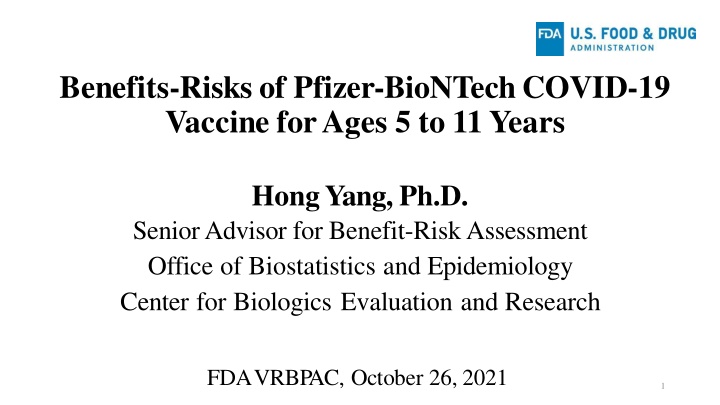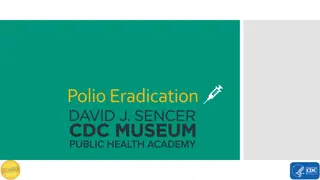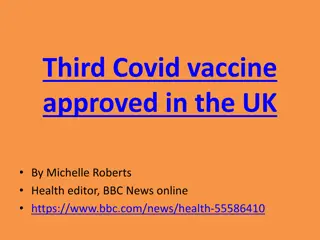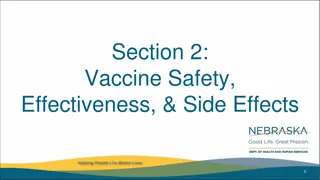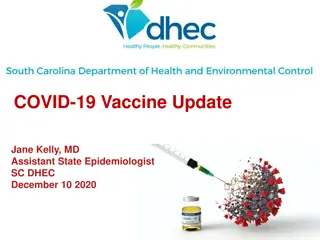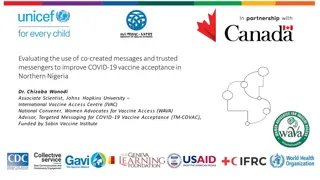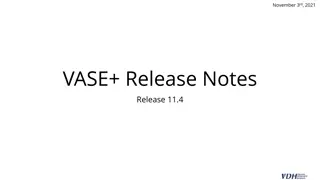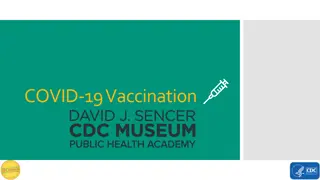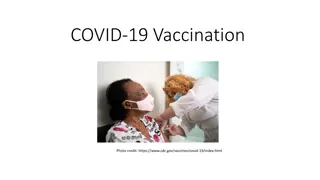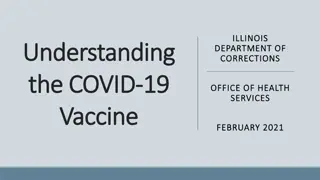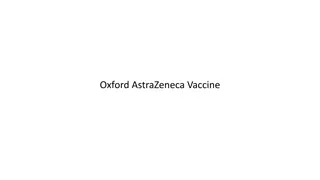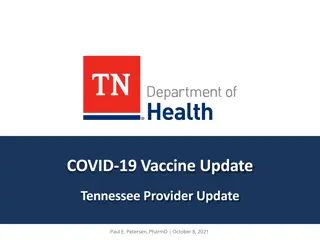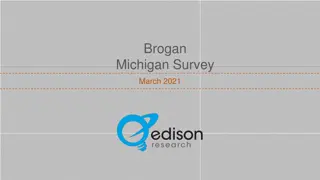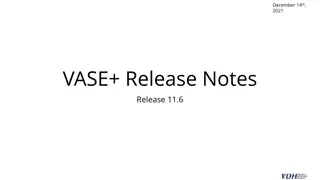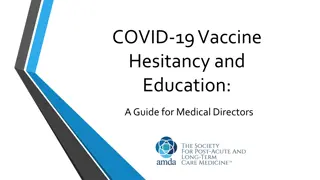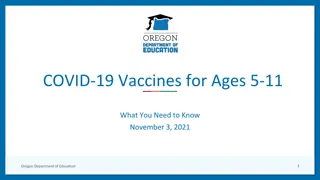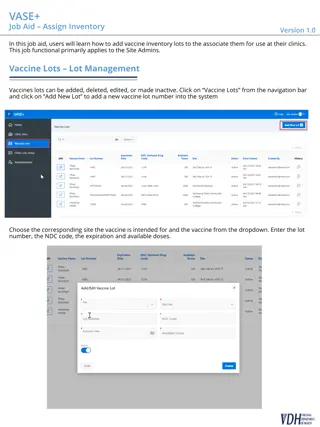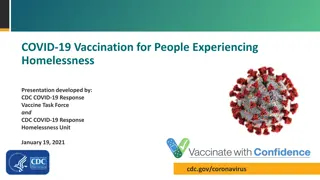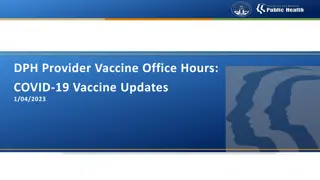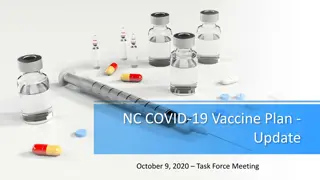Benefits-Risks of Pfizer-BioNTech COVID-19 Vaccine for Ages 5 to 11 Years
Hong Yang, Ph.D., discusses the benefits and risks of the Pfizer-BioNTech COVID-19 vaccine for children aged 5 to 11 years. The analysis covers various factors including COVID-19 incidence rates, vaccine efficacy, duration of protection, and risks of myocarditis/pericarditis. Uncertainties and alternative scenarios are also explored to provide a comprehensive assessment.
Download Presentation

Please find below an Image/Link to download the presentation.
The content on the website is provided AS IS for your information and personal use only. It may not be sold, licensed, or shared on other websites without obtaining consent from the author.If you encounter any issues during the download, it is possible that the publisher has removed the file from their server.
You are allowed to download the files provided on this website for personal or commercial use, subject to the condition that they are used lawfully. All files are the property of their respective owners.
The content on the website is provided AS IS for your information and personal use only. It may not be sold, licensed, or shared on other websites without obtaining consent from the author.
E N D
Presentation Transcript
Benefits-Risks of Pfizer-BioNTech COVID-19 Vaccine for Ages 5 to 11 Years HongYang, Ph.D. Senior Advisor for Benefit-Risk Assessment Office of Biostatistics and Epidemiology Center for Biologics Evaluation and Research FDAVRBPAC, October 26, 2021 1
Benefits and Risks Per 1 Million Fully- Vaccinated (Ages 5 to 11 years/male, female and all sexes) 2
Assumptions and Model Inputs - Scenario 1 (Base) General assumptions Duration of vaccine protection:6 monthspost2nddose (constantvaccine efficacy) Stable COVID-19 pandemic for 6-month period (constantincidence rates for COVID-19 cases, hospitalizations, ICU stays and deaths) Benefits COVID-19related incidencerates: Case: the week of September 11, 2021from CDC Hospitalization:average of four weeks prior to September 11,2021from COVID NET1 ICU stayand death: historicalaverage rates among those hospitalized fromCOVID NET1 Risks Incidenceof excess myocarditis/pericarditis:OPTUMdata for ages 12-15years through July 10 Rate of hospitalization and ICU stay due to vaccinerelated myocarditisfor ages 12-17years: from VaccineSafety Datalink (VSD)3 Hospitalization:87% ICU stay: 32% Vaccineefficacy:70%againstcaseand 80% againsthospitalization,ages 20-64years (Pfizer vaccineefficacystudy2) Myocarditisdeath rate: zero 1COVID NET https://www.cdc.gov/coronavirus/2019-ncov/covid-data/covid-net/purpose-methods.html 2CDC vaccine effectivness study: https://www.cdc.gov/vaccines/acip/meetings/downloads/slides-2021-09-22/04-COVID-Link-Gelles-508.pdf 3ACIP Meeting August 30, 2021: https://www.cdc.gov/vaccines/acip/meetings/downloads/slides-2021-08-30/04-COVID-Klein-508.pdf 3
Key Uncertainties & Alternative Model Scenarios COVID-19 incidence rates Uncertainty in pandemic Scenario 2 (Recent COVID-19 Peak Incidence): incidences of cases & hospitalizations are 20% and 30% higher than incidences the week of September 11, 2021 Scenario 3 (The Lowest COVID-19 Incidence): incidences of cases & hospitalizations are 5% and 10% of the incidences the week of September 11, 2021 COVID-19 death rate Reported death rate by CDC DataTracker is about 3x higher than the rate from COVID NET Scenario 5 (Higher COVID-19 Death Rate): death rate from CDC Data Tracker 4
Key Uncertainties & Alternative Model Scenarios (continued) Vaccine efficacy Asponsor s supportive efficacy analysis1suggests 90.7% efficacy against infection among ages 5-11 years (data accrued through Oct. 8, 2021) Scenario 4 (HigherVaccine Efficacy): 90% against case and 100% against hospitalization Incidence of excessmyocarditis cases The rate for ages 12-17 years is applied to ages 5-11 years for whom the data is not available largevariation on the incidence of excess myocarditis cases among different data sources (such as OPTUM,VSD and V AERS) Scenario 6 (Lower Excess Myocarditis Rate): rate of excess myocarditis cases is 50% lower than that for ages 12-17 years from OPTUM 1Pfizer'sVaccinesand RelatedBiological ProductsAdvisoryCommitteeBriefing Documenton BNT162B2Retrievedfrom https://www.fda.gov/media/153409/downloadonOctober24,2021 5
Scenario 1 (Base) COVID incidences the week of September 11,2021 Vaccine efficacy 70% against case and 80% against hospitalization Rate of excess myocarditis: OPTUM data for ages 12-15 years 7
MALES (Cases Per Million) Note: Median hospitalization length of stay is 6 days for COVIDand1 dayfor vaccinerelated myocarditis 8
Scenario 2 (Recent COVID-19 Peak Incidence) COVID cases are 20% and Hospitalizations are 30% higher than the week September 11,2021 11
Scenario 3 (The Lowest COVID-19 Incidence) COVID cases are 5% and Hospitalizations are 10% of September 11, 2021 13
Scenario 4 (HigherVaccine Efficacy) Vaccine efficacy of 90% against case and 100% against hospitalization 15
Scenario 5 (Higher COVID Death Rate) COVID-19 death rate from CDC DataTracker 17
Scenario 6 (Lower Excess Myocarditis Rate) 50% lower myocarditis case rate compared to data for ages 12-17 years from OPTUM 19
Major Limitations Model assumption about constant incidence rate generates great uncertainty on the estimate of benefits. Vaccine efficacy may change due to new emerging variants of virus Hospitalizations and ICU stays from COVID-19 and myocarditis are not equivalent and cannot directly compared The benefit of reducing COVID related multisystem inflammatory syndrome in children may not be fully captured by preventable hospitalizations, ICU stays and deaths due to COVID-19 This BR risk assessment does not consider potential long-term adverse effects due to either COVID-19 or myocarditis This BR assessment does not include secondary benefits (reducing COVID-19 disease transmission) and risks 21
Conclusions For Scenarios 1 (Base), 2 (Recent COVID-19 Peak Incidence), 4 (Higher Vaccine Efficacy), 5 (Higher COVID-19 Death Rate), and 6 (Lower Excess Myocarditis Rate) the model predicts that benefits of the Pfizer-BioNTech COVID-19 Vaccine2-dose primary series clearly outweigh the risks for ages 5-11 years. For Scenario 3 (The Lowest COVID-19 Incidence), the model predicts more excess hospitalizations and ICU stays due to vaccine-related myocarditis/pericarditis compared to prevented hospitalizations and ICU stays due to COVID-19 in males and in both sexes combined. Considering the different implications and length of stay for COVID-19 hospitalization versus hospitalization for vaccine-associated myocarditis/pericarditis, and benefits related to prevention of cases of COVID-19 with significant morbidity, the overall benefits of the vaccine may still outweigh the risks under this lowest incidence scenario. If the myocarditis/pericarditis risk in this age group is lower than the conservative assumption used in the model, the benefit-risk balance would be even more favorable.22
Acknowledgements Drs. Patrick Funk, OsmanYogurtcu and Richard Forshee for contribution to benefit-risk assessment Vaccine Task Force at the Centers for Disease Control and Prevention shared initial benefit-risk assessment model and data on COVID-19 pandemic Acumen and OPTUM Team provided myocarditis case data Drs. Leslie Ball, SairahThommi, Doran Fink and many other CBER colleagues provided inputs to this analysis 23
